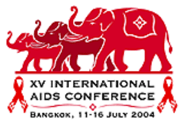 |
 |
 |
| |
New NRTI Reverset for Patients with Nuke Resistance and in Treatment naive: 10-day monotherapy studies
|
| |
| |
|
|
| |
| |
 |
|
| |
| |
Reported by Jules Levin
"Potent anti-HIV Activity of Reverset Following 10 Days of Monotherapy in treatment-Naïve Individuals"
BRIEF SUMMARY
--Mean -1.77 log reduction observed in treatment-naïve patients after 10 days Reverset therapy.
--In 8 treatment-experienced patients, mean HIV viral load reduction was --0.8 log after 10 days following adding reverset to current regimen. Phase IIb study currently enrolling in US, Germany & France.
Background was presented by Rob Murphy (Northwestern University, ACTG). Reverset is a cytidine analog inhibitor of HIV-RT. Preclinical studies demonstrate:
--activity against wild-type HIV-1 and mutants resistant to 3TC, AZT, tenofovir, other NRTIs, NNRTIs, and protease inhibitors
--long intracellular half life of the triphosphate (about 17 hours)
--no mitochondrial toxicity or lactic acid increase in vitro
A single dose clinical study showed:
--excellent bioavailability
--potent anti-HIV activity after a single dose (o.4 log decrease, p<0.001)
Murphy reported resistance that developed with Reverset in vitro. After 20 virus passages mutations occurred at K65R in one cell culture and after 15 virus passages in a second virus culture K65R occurred.
Murphy reported results from a 10-day study in 30 HIV-treatment naïve patients. HIV viral load was >5,000 copies/ml; cd4 count >50 cells. 10 subjects per dose group: 50, 100 or 200 mg once daily for 10 days (8 on active drug, 2 on placebo).
A second group of patients were studied. 10 treatment-experienced patients with HIV viral load >1000 copies/ml; cd4 count >50 cells; patients received 200 mg (n=8) or placebo (n=2) added to current regimen.
VIRAL LOAD REDUCTION IN TREATMENT-NAÏVE
In the naïve group, baseline viral load was on average 4.29 log, cd4 count ranged from 353-645 and was 468 on average across the 3 dose groups. After 10 days on the drug viral load reduction was --1.77 log in the 200 mg dose group, -1.67 log in the 50 mg group, and --1.74 in the 100 mg group. In the 200 mg group, 100% had >1 log drop in viral load, and 100% had 1.5 log or more drop in viral load. 87% in the 200 mg group had <400 copies/ml and 25% had <50 copies/ml.
SUMMARY OF PHARMACOKINETICS (PK)
The Cmax was higher in the 200 mg dose group & Murphy said it is thought that the Cmax in NRTIs predict antiviral activity: Mean Cmax 2.3 uM in the 50 mg group, 5.4 in the 100 mg group, and 9.8 in the 200 mg group. Plasma half life was mean 5.2 hours in the 200 mg group, 5.2 hrs in the 100 mg group, and 4.0 hrs in the 50 mg group.
PK on DAY 10 (Mean, n=8)
| Parameter | 50 mg | 100mg | 200mg | | Cmax (uM) | 2.3 | 5.4 | 9.8 | | Tmax (h) | 3.1 | 3.2 | 3.1 | | Half-life (h) | 4.0 | 5.2 | 5.2 | | AUC(Um*h) | 11.9 | 31.7 | 74.6 |
REVERSET ACTIVITY AGAINST MUTANT STRAINS OG HIV IN-VITRO
Fold-Change From Average Wild-Type
Cmax at 200 mg dose = 5.2 fold WT (9.8 uM)
Average Wild-Type: 0.4 to -.04
K65R: 3.2
K65R+V179): 2.7
K65R+F214L+K122E: 0.2
L74V: 0.6
M184V: 0.4
T215Y: 0.2
MULTIPLE THYMIDINE ANALOGUE MUTANTS
M41L/T215Y: -0.6
M184V/T215Y: -0.8
D67N/K70R/M184V/T215Y/M2190:-0.6
D67N/K70R/K103N/T215Y: -0.3
M41L/D67N/M184V/T215Y: 1.4
M41/K103N/M184V/T215Y: -0.9
RESISTANT STRAINS
D69 insertions: 18.4
Q151 MDR: 72.5
TREATMENT-EXPERIENCED PATIENTS
Baseline Characteristics
| RCT 200mg
N=8 | Placebo
n=2 | | Mean HIV RNA: | 4.10 log | 4.32 | | Mean Cd4 count: | 470 | 288 | | Mean # of prior regimens | 5.5 | 3.5 | | >3 TAMS w/M41L or L210W | 4/8 | 0/2 | | TDF in current regimen | 5/8 | 1/2 | | 3TC in current regimen | 5/8 | 1/2 |
PRELIMINARY RESULTS on MEAN CHANGE in HIV RNA FOLLOWING DOSING of EXPERIENCED PATIENTS with 200 mg RVT or PLACEBO for 10 DAYS ADDED to CURRENT REGIMEN
Reverset: -0.8 log
Placebo patient #1: 0.2 log
Placebo patient #2: -1.0 log
--4/8 subjects receiving RVT achieved <400 copies/ml, 1/8 <50 copies/ml
--RVT equally effective in failing background regimens including 3Tc and/or TDF
--no treatment emergent mutations
--response in one placebo patient likely due to renewed adherence to current background therapy (WT at baseline)
Of note, after Rverset was stopped on day 10 viral load started to increase but did not return to baseline, it remained at a --0.4 log reduction.
MURPHY'S CONCLUSIONS
The Cmax at the 200 mg dose exceeds the EC90 of wild-type, K65R, M184V, and multiple TAMS.
Once daily dosing supported the in vitro intracellular RVT-TP half-life (about 17 hours), the plasma half-life (5.2 hours), and clinical antiviral activity.
No changes in genotype were noted following 10 days of monotherapy in treatment-naïve or experienced patients (note from Jules Levin: presumably they used standard gentype testing while at the recent Resistance Wksp studies showed that genotypic mutations could be found using very sensitive genotype testing when standard testing could not find mutations).
Reverset is a highly potent oral once daily nucleoside in treatment-naïve patients:
--at 200mg QD, a 1.77 mean log reduction in HIV viral load was observed after 10 days
--87.5% <400 copies/ml
Preliminary data indicate that Reverset is a potent inhibitor of HIV in treatment-experienced patients when added to a failing regimen
--at 200 mg QD, a mean 0.8 log reduction in HIV RNA was observed after 10 days of add-on therapy
--50% <400 copies/ml
--further analysis will include response by genotype
--Reverset is well tolerated with no significant clinical oe lab adverse events
--A phase IIb study is currently enrolling treatment-experienced patients in US, Germany, and France.
Ý
|
| |
|
 |
 |
|
|